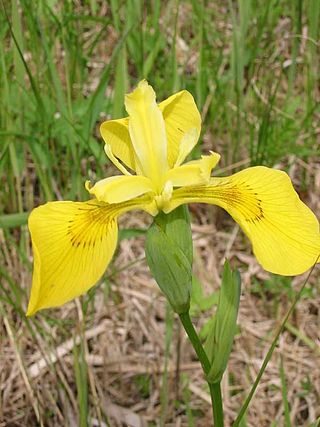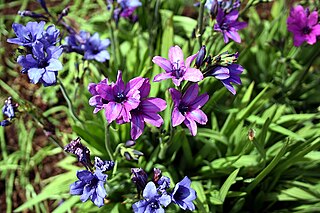
Asparagales is an order of plants in modern classification systems such as the Angiosperm Phylogeny Group (APG) and the Angiosperm Phylogeny Web. The order takes its name from the type family Asparagaceae and is placed in the monocots amongst the lilioid monocots. The order has only recently been recognized in classification systems. It was first put forward by Huber in 1977 and later taken up in the Dahlgren system of 1985 and then the APG in 1998, 2003 and 2009. Before this, many of its families were assigned to the old order Liliales, a very large order containing almost all monocots with colorful tepals and lacking starch in their endosperm. DNA sequence analysis indicated that many of the taxa previously included in Liliales should actually be redistributed over three orders, Liliales, Asparagales, and Dioscoreales. The boundaries of the Asparagales and of its families have undergone a series of changes in recent years; future research may lead to further changes and ultimately greater stability. In the APG circumscription, Asparagales is the largest order of monocots with 14 families, 1,122 genera, and about 36,000 species.

Crocus is a genus of seasonal flowering plants in the family Iridaceae comprising about 100 species of perennials growing from corms. They are low growing plants, whose flower stems remain underground, that bear relatively large white, yellow, orange or purple flowers and then become dormant after flowering. Many are cultivated for their flowers, appearing in autumn, winter, or spring. The flowers close at night and in overcast weather conditions. The crocus has been known throughout recorded history, mainly as the source of saffron. Saffron is obtained from the dried stigma of Crocus sativus, an autumn-blooming species. It is valued as a spice and dyestuff, and is one of the most expensive spices in the world. Iran is the center of saffron production. Crocuses are native to woodland, scrub, and meadows from sea level to alpine tundra from the Mediterranean, through North Africa, central and southern Europe, the islands of the Aegean, the Middle East and across Central Asia to Xinjiang in western China. Crocuses may be propagated from seed or from daughter cormels formed on the corm, that eventually produce mature plants. They arrived in Europe from Turkey in the 16th century and became valued as an ornamental flowering plant.

Iridaceae is a family of plants in order Asparagales, taking its name from the irises, meaning rainbow, referring to its many colours. There are 66 accepted genera with a total of c. 2244 species worldwide. It includes a number of other well known cultivated plants, such as freesias, gladioli and crocuses.

Babiana is a genus of geophytes in the family Iridaceae with 93 recognized species as of March 2022. The leaves consist of a stalk and a blade that are at an angle to each other. The leaf blades are entire, laterally flattened and pleated, and often hairy. Each individual flower is subtended by two hairy or smooth bracts that are green in most species. The outer bract is often the largest of the two. In most species the bracts have a dry, brown tip, but in a few species it is entirely green or entirely dry when flowering or the outer bract is translucent and has a papery texture. The inner bract is forked or split all the way to its base. Each flower is without a pedicel, with six tepals that are merged at their base into a tube and form a perianth that is mirror-symmetrical in most species, with three anthers implanted where the perianth tube widens and that are, in almost every species, clustered at one side of the style. The style has three branches that widen towards the tip and the ovary is inferior. Flowers occur in almost every conceivable colour, many have markings on some of the tepals, and few star-symmetrical flowers have a centre that strongly contrasts with the free part of the perianth. The majority of these species are endemic to the west and southwest of South Africa, and southwestern Namibia, but one species occurs elsewhere in Namibia and South Africa and another species can be found in Botswana, Namibia, South Africa, Zambia and Zimbabwe. The genus name is derived from the Dutch word baviaan, referring to the Chacma baboon, Papio ursinus, that consumes the corms of plants in the genus. The genus is called bobbejaantjie in Afrikaans, meaning small baboon.

Babiana stricta, the baboon flower or blue freesia, is a species of flowering plant in the family Iridaceae, native to Cape Province, South Africa and naturalized in Australia. Growing 10–30 cm (4–12 in) tall by 5 cm (2 in) broad, it is a cormous perennial with hairy leaves 4–12 cm (2–5 in) long. The leaves show linear venation.

Irideae is a tribe included in the well-known family Iridaceae. It contains many species in five genera which are widely distributed in the Old World. The tribe derives its name from Iris, which is the largest genus of the tribe.

Trimezieae is a tribe included in the subfamily Iridoideae of the family Iridaceae. It is the smallest tribe in this subfamily, containing only three closely related genera.

Watsonieae is the second largest tribe in the subfamily Crocoideae and named after the best-known genus in it — Watsonia. The members in this group are widely distributed in Africa, mainly in its southern parts.

Sisyrinchieae is the second largest tribe in the subfamily Iridoideae. The group is included in the family Iridaceae. It contains many perennials which are widely distributed in the New World.
Cyanixia is a genus of plants in the Iridaceae, first described in 2003. It contains only one known species, Cyanixia socotrana, a perennial, herbaceous and bulbous plant species endemic to the Island of Socotra in the Indian Ocean, part of the Republic of Yemen.

Miriam Phoebe de Vos was a leading South African botanist and academic. She was an expert on bulbous plants, especially Romulea. She also had a special interest in Moraea and Clivia.

The Asparagales are an order of plants, and on this page the structure of the order is used according to the APG III system. The order takes its name from the family Asparagaceae and is placed in the monocots. The order is clearly circumscribed on the basis of DNA sequence analysis, but is difficult to define morphologically, since its members are structurally diverse. The APG III system is used in World Checklist of Selected Plant Families from the Royal Botanical Gardens at Kew. With this circumscription, the order consists of 14 families with approximately 1120 genera and 26000 species.
Peter Goldblatt is a South African botanist, working principally in the United States.

Romulea tortuosa is a herbaceous perennial geophyte in the family Iridaceae native to South Africa. It has a small corm in the soil, a few prostrate coiling leaves, and fragrant, trimerous yellow flowers, sometimes with six brown blotches on the inside near the bottom of the flower.

Babiana villosa is a species of geophyte of 10–20 cm (3.9–7.9 in) high that is assigned to the family Iridaceae. It has mauve-pink, purple or scarlet star-symmetrical wide chalice-shaped flowers with narrow tube, large, blackish or dark purple anthers, and velvety hairy, lance-shaped, laterally compressed leaves, set in a fan. Flowers occur during August and September. Its grows between Malmesbury and Wellington in the Western Cape province of South Africa. It is commonly called red babiana in English and rooibobbejaantjie in Afrikaans.

Babiana hirsuta is a species of geophyte of 40–70 cm (16–28 in) high that is assigned to the family Iridaceae. It has many scarlet mirror-symmetrical flowers in a branched inflorescence with several short ascending branches. The flower has a narrow tube, and three large, blackish or dark purple anthers that extend beyond the dorsal tepal. The leaves are velvety hairy, lance-shaped, laterally compressed and set in a fan. It is an endemic species of South Africa that can be found along the west coast of the Northern and Western Cape provinces as far south as Saldanha. It is called red babiana in English, but that name is also applied to Babiana villosa, and strandlelie, sandlelie and rooihanekam in Afrikaans. Until 2008, the strandlelie was known as Babiana thunbergii.

Babiana tubiflora is a species of geophyte of 7–15 cm (2.8–5.9 in) high that is assigned to the family Iridaceae. It has whitish mirror-symmetrical flowers with a long narrow tube that split into six tepal lobes, have three stamens, and line- to lance-shaped, laterally compressed leaves. It is an endemic species of South Africa that can be found along the west and south coast of the Western Cape province. It flowers from August to early October.

Babiana sambucina is a species of geophyte of 8–30 cm (3.1–11.8 in) high that is assigned to the family Iridaceae. It has dense spikes of blue to violet-coloured, often fragrant flowers. There are two subspecies, B. sambucina subsp. longibracteata is restricted to a small area in the Northern Cape, B. sambucina subsp. sambucina grows in the Western Cape and Eastern Cape provinces of South Africa. Flowers are present in August and September.

Babiana mucronata is a perennial plant species that grows to about 5–18 cm (2.0–7.1 in) high and annually forms leaves and flowers from an underground corm. It is assigned to the iris family. The leaves are line- to sickle-shaped, slightly pleated, thinly hairy or hairless and 7–20 mm (0.28–0.79 in) wide. It has a simple or branched, more or less upright spike of 3-12 dark to pale violet-blue, mirror-symmetrical flowers. Each flower consists of a perianth that is merged below into a funnel-shaped tube of 10–25 mm (0.39–0.98 in) long but splits into six unequal tepals. The dorsal tepal forms the upper lip and is 25–35 mm (0.98–1.38 in) long. The remaining tepals together form the lower lip, are merged for 3–5 mm (0.12–0.20 in) further, and the lower tepals are 15–18 mm (0.59–0.71 in) long and adorned with white to pale yellow blotches that are offset with a darker violet-blue edge. Three stamens are curved, crowded near the upper lip, and carry pale violet anthers. Flowers may be found between late July and September.















